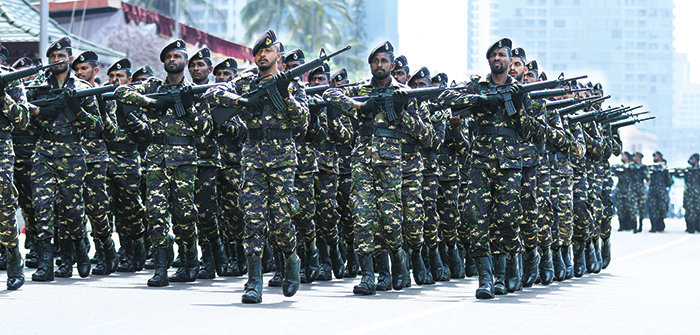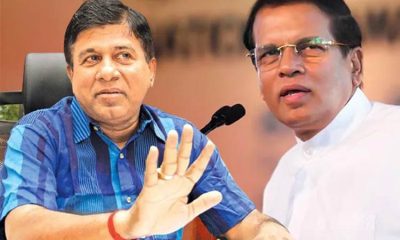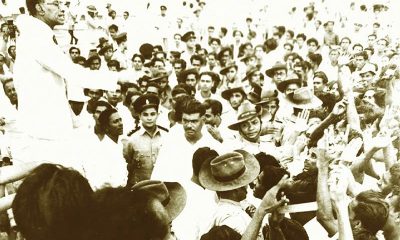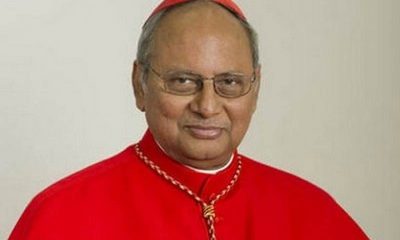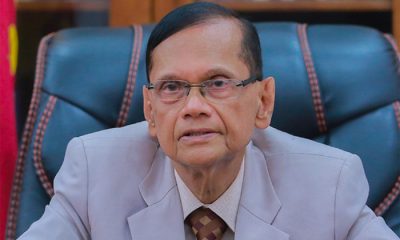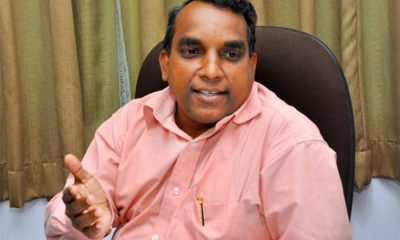Features
Election ’24: Judicial Evolution, Power Devolution, and a New Tamil Leader
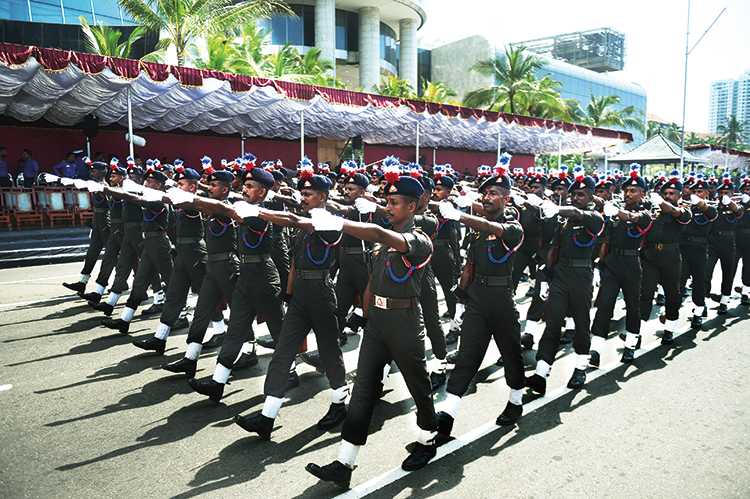
by Rajan Philips
Sunday this week marks Sri Lanka’s 76th independence anniversary. By President Ranil Wickremesinghe’s reckoning another twenty four years will have to go by before Sri Lanka’s economy could fully recovery from the man made crisis it contracted two years ago. And what is immediately ahead is a “grueling recovery path.” That is the grim warning of Dushni Weerakoon, the respected Economist.
Another Economist from abroad, Prof. Mick Moore, who coined the phrase “man-made crisis” to describe Gota’s debacle, has now advised that it is time for Sri Lanka to have an “authentic finance minister” after more than 30 years. Like the UB Wanninayake’s, NM Perera’s and Ronnie de Mel’s of old. Not the tandem Executive President / Finance Minister model of today.
Can that happen with the current presidential system? That brings us back to political square one, which is the constitution. To where I left last week and to a somewhat significant political development since. Namely, the election of Sivagnanam Shiritharan as the new leader of the Ilankai Thamil Arasu Kadchi (ITAK), the old Federal Party in English, now stuck with its Tamil only version. The election of Mr. Shiritharan, and the defeat of MA Sumanthiran, eminent lawyer and parliamentarian, has triggered editorial waves in the news media.
New Equilibrium
Depending on which glass they are looking at, pundits have described the ITAK leadership election as – either not an overwhelming victory (for Shiritharan) or as a significant defeat (for Sumanthiran). Whatever it may be, the election of Mr. Shiritharan is not going to be without political implications. That much is obvious, but what needs to be borne in mind is that the significance of these implications will vary from context to context and from issue to issue.
It would be wrong to over interpret the new leader’s misgivings the 13th Amendment and use it an excuse to shelve it without implementing it. Or to see something utmost sinister in his rhetorical assertions about Tamil nationalism and his memorialization of “Eelam national liberation fighters.” As I have argued earlier, memorialization is collective therapy after a violent experience, and hollering about it or trying to stop it is futile. The other side of the coin of memorial politics is that nothing more can be done other than commemorations.
This is the crux of the new equilibrium in the dynamic between the Sri Lankan state and the Sri Lankan Tamils that has been taking shape after 1983. Unlike pre-1983,the state is highly circumscribed in what it can and cannot do vis-a-vis the Tamils, by the emergence of the Tamil diaspora and international attention. The Tamils are no less circumscribed in what they can and cannot achieve by the same international attention and the limiting ground realities at home that weigh against the dreamy aspirations among sections of the diaspora. India obviously looms large in this picture with or without Modi and his distortion of the Mahatma’s Ram Rajya. Additionally, the nationalistic coming of age of the Muslims and the plantation Tamils has created structural curtailments on at least the territorial claims of Tamil nationalism.
The task for leadership on all sides would be to find a consociational working area within the highly constrained spaces and produce meaningful action. Ideally the task of all leaders in the current situation should be to focus on the economy, and the debate about the economy should be the focus of the election. That is unfortunately not the case and there is reasonably legitimate concern that the elections are casting “a shadow of uncertainty over economic recovery” (Dushni Weerakoon, Sunday Island, January 28). But without elections there will be the double whammy of political and economic uncertainties.
Put another way, you cannot get over the crisis of one uncertainty without dealing with the crisis of the other simultaneously. There is not going to be economic recovery without political and constitutional reforms at the same time. Therein is the timeliness of the constitutional reform proposals put forward by the Collective for Democracy and Rule of Law (CDRL). Last week, I touched on the proposals for parliamentary and presidential reforms for achieving a healthy balance of powers between the different branches of the state. The proposals also address the judiciary, judicial review of legislation, cross-over MPs, and the system for power devolution.
Judicial Evolution and Power Devolution
Of all the branches of the Sri Lankan state, the judiciary is not only the oldest but also the most evolved, and more so in the matter of devolving power. The evolutionary breakthrough was the landmark Supreme Court ruling, on August 4, 2017. Three judges of the Supreme Court, then Chief Justice Priyasath Dep, Justice Upali Abeyratne and Justice Anil Gooneratne, held that advocating for a federal form of government would not be a violation of the Sri Lankan constitution.
The judges were dismissing a petition against the Ilankai Thamizh Arasu Kadchi that it was in violation of the constitution because in advocating for a federal form government the ITAK was pursuing the goal of a separate state. The judges disagreed and pointed to the 13th Amendment as an example of devolving power without violating the constitution.
The August 2017 Supreme Court ruling could be a starting point for the new ITAK leader. A much better starting point for Mr. Shiritharan than what had been for all his predecessors who were faced with court rulings that failed to stop the legislature and the executive from violating the fundamental of minorities in cases involving citizenship, language, land and even religion.
The citizenship issue is now resolved and the estate Tamils have their own political representation. After 13A, Sri Lanka has both Sinhala and Tamil as official languages, and English is recognized as a link language. There are also moves to facilitate English as a medium of instruction for everyone by providing government funds to private schools. What is missing are functioning institutions for power devolution and local democracy. And that is because there have been no provincial council elections for nearly a decade and no local government elections since February 2018.
The Constitutional proposals respond to the current state of affairs by suggesting enshrining of the right to vote at provincial and local elections in the constitutional provisions protecting the franchise right to vote at national elections. The proposals also respond to the failure of successive ‘central governments’ to facilitate the orderly and efficient functioning of provincial council and local bodies.
The contentious issues over police and land powers can never be fully addressed or agreed upon in writing without functioning provincial councils on the ground. All elections are overdue and the proposals for implementing devolution will remain proposals until provincial elections are held and determined efforts are made to make them work. What seems to be a new mechanism in the proposals is the recommendation for including safeguards against session, including suspension of a recalcitrant provincial council by presidential proclamation, which would subject to approval by both Houses of Parliament, and review by the Constitutional Court.
The proposals seek to bring back the Constitutional Court that was the most innovative feature of the First Republican Constitution and one that could have continued in the Second (and current) Republican Constitution. That is insofar as the current constitution is partly modelled on the French Constitution that provides for preview of legislations by a constitutional court. The proposals note that there is “a welcome trend” in Sri Lanka in that “more citizens and civic organisations are coming forward to challenge Bills before the Supreme Court.
The proposals allude to permitting post-enactment judicial review of laws and Provincial statutes. That would be a big change reverting to pre-1972 traditions. And involving the Constitutional Court to handle both judicial preview of and post-enactment review of laws would be worth the effort, but the challenges should not be underestimated.
My last comment is about a matter that involves the legislature, viz., cross-over MPs. The experience of cross-over MPs and the practice of inducing crossovers with cabinet positions to secure a voting majority, are seen to have been a major factor in eroding public trust in politics in Sri Lanka. A more fundamental reason could be the qualification of candidates who end up as MPs based on a system of list-based nominations. The suggested proposals to address this by providing for a member to lose her/his seat for voting against a decision of the Party seems harsh. Forcing a member to lose seat for joining another party could be a more plausible ground for vacating the seat. The proposals do include safeguards for MPs who have contested as coalition partners. And the recommendation to hold by-elections to fill a vacated constituency seat is a welcome change.
Interestingly, comparative parliamentary studies draw a distinction between old and nascent parliamentary systems in dealing with cross-over MPs. In older, i.e., western, democracies MPs do not have to vacate their seats for voting against the party line or leaving the party that she/he entered parliament with. Not so in the so called nascent, non-western, democracies. India and Bangladesh are among them, but here at home Dr NM Perera was dead set against the provisions in the current constitution for dealing with crossover MPs and vacated seats. It was not so before 1978.
When the LSSP left the United Front government in 1976, some SLFP MPs called for the resignation of NM Perera as a Member of Parliament. He responded in style and citied the example of “illustrious predecessors: SWRD Bandaranaike, who left the UNP government to create the SLFP; and SJV Chelvanayakam, who left the Tamil Congress to start new Tamil political party – the Ilankai Thamil Arasu Kadchi. That is an appropriate segue to revisit the trajectories of Tamil political leaders, past and present.
Features
Democracy faces tougher challenges as political Right beefs-up presence

 It is becoming increasingly evident that the democracy-authoritarianism division would be a major polarity in international politics going forward. It shouldn’t come as a surprise if quite a few major states of both East and West gain increasing inspiration from the ‘world’s mightiest democracy’ under President Donald Trump from now on and flout the core principles of democratic governance with impunity.
It is becoming increasingly evident that the democracy-authoritarianism division would be a major polarity in international politics going forward. It shouldn’t come as a surprise if quite a few major states of both East and West gain increasing inspiration from the ‘world’s mightiest democracy’ under President Donald Trump from now on and flout the core principles of democratic governance with impunity.
It is the political Right that would gain most might in this evolving new scheme of things. Whether it be the US itself, France, Israel or Turkey, to name just a few countries in the news, it is plain to see that the Right is unleashing its power with hardly a thought for the harm being done to key democratic institutions and norms.
In fact, Donald Trump and his Republican hard liners led from the front, so to speak, in this process of unleashing the power of the Right in contemporary times. It remains a very vital piece of history that the Right in the US savaged democracy’s most valued institutions on January 6, 2021, when it ran amok with the tacit backing of Trump in the US Capitol.
What was being challenged by the mob most was the ‘will of the people’ which was manifest in the latter’s choice of Joe Biden as US President at the time. To date Trump does not accept that popular verdict and insists that the election in question was a flawed one. He does so in the face of enlightened pronouncements to the contrary.
The US Right’s protégé state, Israel, is well on course to doing grave harm to its democratic institutions, with the country’s judiciary being undermined most. To cite two recent examples to support this viewpoint, the Israeli parliament passed a law to empower the country’s election officials to appoint judges, while Prime Minister Netanyahu has installed the new head of the country’s prime security agency, disregarding in the process a Supreme Court decision to retain the former head.
Such decisions were made by the Netanyahu regime in the face of mounting protests by the people. While nothing new may be said if one takes the view that Israel’s democratic credentials have always left much to be desired, the downgrading of a democratic country’s judiciary is something to be sorely regretted by democratic opinion worldwide. After all, in most states, it is the judiciary that ends up serving the best interests of the people.
Meanwhile in France, the indications are that far Right leader Marine Le Pen would not be backing down in the face of a judicial verdict that pronounces her guilty of corruption that may prevent her from running for President in 2027. She is the most popular politician in France currently and it should not come as a surprise if she rallies further popular support for herself in street protests. Among other things, this will be proof of the growing popular appeal of the political Right. Considering that France has been a foremost democracy, this is not good news for democratic opinion.
However, some heart could be taken from current developments in the Gaza and Turkey where the people are challenging their respective dominant governing forces in street protests largely peacefully. In the Gaza anti-Hamas protests have broken out demanding of the group to step down from power, while in Turkey, President Erdogan’s decades-long iron-fist rule is being challenged by pro-democracy popular forces over the incarceration of his foremost political rival.
Right now, the Turkish state is in the process of quashing this revolt through a show of brute force. Essentially, in both situations the popular demand is for democracy and accountable governance and such aims are generally anathema in the ears of the political Right whose forte is repressive, dictatorial rule.
The onus is on the thriving democracies of the world to ensure that the Right anywhere is prevented from coming to power in the name of the core principles and values of democracy. Right now, it is the European Union that could fit into this role best and democratic opinion is obliged to rally behind the organization. Needless to say, peaceful and democratic methods should be deployed in this historic undertaking.
Although the UN is yet to play an effective role in the current international situation, stepped up efforts by it to speed up democratic development everywhere could yield some dividends. Empowerment of people is the goal to be basically achieved.
Interestingly, the Trump administration could be seen as being in league with the Putin regime in Russia at present. This is on account of the glaringly Right wing direction that the US is taking under Trump. In fact, the global balance of political forces has taken an ironic shift with the hitherto number one democracy collaborating with the Putin regime in the latter’s foreign policy pursuits that possess the potential of plunging Europe into another regional war.
President Trump promised to bring peace to the Ukraine within a day of returning to power but he currently is at risk of cutting a sorry figure on the world stage because Putin is far from collaborating with his plans regarding Ukraine. Putin is promising the US nothing and Ukraine is unlikely to step down from the position it has always held that its sovereignty, which has been harmed by the Putin regime, is not negotiable.
In fact, the China-Russia alliance could witness a firming-up in the days ahead. Speculation is intense that the US is contemplating a military strike on Iran, but it would face strong opposition from China and Russia in the event of such an adventurist course of action. This is on account of the possibility of China and Russia continuing to be firm in their position that Western designs in the Gulf region should be defeated. On the other hand, Iran could be expected to hit back strongly in a military confrontation with the US.
Considering that organizations such as the EU could be expected to be at cross-purposes with the US on the Ukraine and connected questions, the current world situation could not be seen as a replication of the conventional East-West polarity. The East, that is mainly China and Russia, is remaining united but not so the West. The latter has broadly fragmented into a democratic states versus authoritarian states bipolarity which could render the international situation increasingly unstable and volatile.
Features
Chikungunya Fever in Children

Chikungunya fever, a viral disease transmitted by mosquitoes, poses a significant health concern, particularly for children. It has been around in Sri Lanka sporadically, but there are reports of an increasing occurrence of it in more recent times. While often associated with debilitating joint pain in adults, its manifestations in children can present unique challenges. Understanding the nuances of this disease is crucial for effective management and prevention.
Chikungunya fever is caused by the chikungunya virus (CHIKV), an alphavirus transmitted to humans through the bites of infected Aedes aegypti and Aedes albopictus mosquitoes. These are the same mosquitoes that transmit dengue and Zika viruses, highlighting the overlapping risks in many areas of the world. It is entirely possible for chikungunya and dengue to co-circulate in the same area, leading to co-infections in individuals.
When a mosquito bites a person infected with CHIKV, it ingests the virus. After a period of growth and multiplication of the virus within the mosquito, the virus can be transmitted to another person through subsequent bites. Therefore, the mosquito acts as a vector or an intermediate transmitting agent that spreads the disease, but not as a reservoir of the disease. The spread of chikungunya is influenced by environmental factors that support mosquito breeding, such as stagnant water and warm climates. Urbanization and poor sanitation can exacerbate the problem by creating breeding grounds for these mosquitoes.
The clinical presentation of chikungunya in children can vary, ranging from mild to severe. While some infected children may even be asymptomatic and be normal for all intents and purposes, others can experience a range of symptoms, including a sudden onset of high fever, a common initial symptom. Pain in the joints of the body, while being a hallmark of chikungunya in adults, may be less pronounced in children. However, they can still experience significant discomfort and this must be kept in mind during processes of diagnosis and treatment. It is also important to remember that joint pains can present in various forms, as well as in different locations of the body. There is no characteristic pattern or sites of involvement of joints. Muscle aches and pains can accompany the fever and joint pain as well. A headache, too, could occur at any stage of the disease. Other symptoms may include nausea, vomiting, and fatigue as well.
A reddish elevated rash, referred to in medical jargon as a maculopapular rash, is frequently observed in children, sometimes more so than in adults. While chikungunya is known to cause such a rash, there is a specific characteristic related to nasal discoloration that is worth noting. It is called the “Chik sign” or “Brownie nose” and refers to an increased darkening of the skin, particularly on the nose. This discolouration just appears and is not associated with pain or itching. It can occur during or after the fever, and it can be a helpful clinical sign, especially in areas with limited diagnostic resources. While a generalised rash is a common symptom of chikungunya, a distinctive darkening of the skin on the nose is a particular characteristic that has been observed.
In some rare instances, particularly in infants and very young children, chikungunya can lead to neurological complications, such as involvement of the brain, known as encephalitis. This is associated with a change in the level of alertness, drowsiness, convulsions and weakness of limbs. Equally rarely, some studies indicate that children can experience bleeding tendencies and haemorrhagic manifestations more often than adults.
Diagnosis is typically made through evaluating the patient’s symptoms and medical history, as well as by special blood tests that can detect the presence of CHIKV antibodies (IgM and IgG) or the virus itself through PCR testing.
There is no specific antiviral treatment for chikungunya. Treatment focuses on relieving symptoms and allowing the body to recover on its own. Adequate rest is essential for recovery, and maintaining hydration is crucial, especially in children with fever. Paracetamol in the correct dosage can be used to reduce fever and pain. It is important to avoid aspirin, as it can increase the risk of a further complication known as Reye’s syndrome in children. In severe cases, hospitalisation and supportive care may be necessary.
While most children recover from chikungunya without any major issues, some may experience long-term sequelae. Joint pain can persist for months or even years in some individuals, impacting their quality of life. In rare cases, chikungunya can lead to chronic arthritis. Children that have suffered from neurological complications can have long term effects.
The ultimate outcome or prognosis for chikungunya in children is generally favourable. Most children recover fully within a few days or a couple of weeks. However, the duration and severity of symptoms can vary quite significantly.
Prevention is key to controlling the spread of chikungunya. Mosquito control is of paramount importance. These include eliminating stagnant water sources where mosquitoes breed, using mosquito repellents, wearing long-sleeved clothing and pants, using mosquito nets, especially for young children and installing protective screens on windows and doors. While a chikungunya vaccine is available, its current use is mainly for adults, especially those traveling to at risk areas. More research is being conducted for child vaccinations.
Chikungunya outbreaks can strain healthcare systems and have significant economic consequences. Public health initiatives aimed at mosquito control and disease surveillance are crucial for preventing and managing outbreaks.
Key considerations for children are that some of them, especially infants and young children, are more vulnerable to severe chikungunya complications and early diagnosis and supportive care are essential for minimising the risk of long-term sequelae. Preventing mosquito bites is the most effective way to protect children from chikungunya. By understanding the causation, clinical features, treatment, and prevention of chikungunya, parents, caregivers, and healthcare professionals can work together to protect children from this illness that could sometimes be quite debilitating.
 Dr B. J. C. Perera
Dr B. J. C. Perera
MBBS(Cey), DCH(Cey), DCH(Eng), MD(Paed), MRCP(UK), FRCP(Edin), FRCP(Lond), FRCPCH(UK), FSLCPaed, FCCP, Hony. FRCPCH(UK), Hony. FCGP(SL)
Specialist Consultant Paediatrician and Honorary Senior Fellow, Postgraduate Institute of Medicine, University of Colombo, Sri Lanka.
Joint Editor, Sri Lanka Journal of Child Health and Section Editor, Ceylon Medical Journal
Founder President, Sri Lanka College of Paediatricians – 1996-97)
Features
The Great and Little Traditions and Sri Lankan Historiography

Power, Culture, and Historical Memory:
(Continued from yesterday)
Newton Gunasinghe, a pioneering Sri Lankan sociologist and Marxist scholar, made significant contributions to the study of culture and class in Sri Lanka by incorporating the concepts of great and little traditions within an innovative Marxist framework. His theoretical synthesis offered historians a fresh perspective for evaluating the diversity of past narratives.
At the same time, Michel Foucault’s philosophical intervention significantly influenced the study of historical knowledge. In particular, two of his key concepts have had a profound impact on the discipline of history:
1. The relationship between knowledge and power – Knowledge is not merely an objective truth but a manifestation of the power structures of its time.
2. The necessity of considering the ‘other’ in any conceptual construction – Every idea or framework takes shape in relation to its opposite, highlighting the duality inherent in all intellectual constructs.
These concepts challenged historians to rethink their approaches, prompting them to explore the dynamic interplay between knowledge, power, and culture. The existence of Little Tradition prompted historians to pay attention to ‘other’ histories.
The resurgence of ethnic identities and conflicts has brought renewed attention to the dichotomy of culture, steering the discourse in a new direction. The ethnic resurgence raises three key issues. First, the way non-dominant cultures interpret the past often differs from the narratives produced by dominant cultures, prompting the question: What is historical truth? Second, it underscores the importance of studying the histories of cultural identities through their own perspectives. Finally, and most importantly, it invites reflection on the relationship between ‘Little Traditions’ and the ‘Great Tradition’—how do these ‘other’ histories connect to broader historical narratives?
When the heuristic construct of the cultural dichotomy is applied to historical inquiry, its analytical scope expands far beyond the boundaries of social anthropology. In turn, it broadens the horizons of historical research, producing three main effects:
1. It introduces a new dimension to historical inquiry by bringing marginalised histories to the forefront. In doing so, it directs the attention of professional historians to areas that have traditionally remained outside their scope.
2. It encourages historians to seek new categories of historical sources and adopt more innovative approaches to classifying historical evidence.
3. It compels historians to examine the margins in order to gain a deeper understanding of the center.
The rise of a new theoretical school known as Subaltern Studies in the 1980s provided a significant impetus to the study of history from the perspective of marginalised and oppressed groups—those who have traditionally been excluded from dominant historical narratives and are not linked to power and authority. This movement sought to challenge the Eurocentric and elitist frameworks that had long shaped the study of history, particularly in the context of colonial and postcolonial societies. The writings of historians such as Ranajit Guha and Eric Stokes played a pioneering role in opening up this intellectual path. Guha, in particular, critiqued the way history had been written from the perspective of elites—whether colonial rulers or indigenous upper classes—arguing that such narratives ignored the agency and voices of subaltern groups, such as peasants, laborers, and tribal communities.
Building upon this foundation, several postcolonial scholars further developed the critical examination of power, knowledge, and representation. In her seminal essay Can the Subaltern Speak?, Gayatri Chakravorty Spivak questioned whether marginalized voices—especially those of subaltern women—could truly be represented within dominant intellectual and cultural frameworks, or whether they were inevitably silenced by hegemonic. Another major theorist in this field, Homi Bhabha, also focused on the relationship between knowledge and social power relations. His analysis of identity formation under colonialism revealed the complexities of power dynamics and how they persist in postcolonial societies.
Together, these scholars significantly reshaped historical and cultural studies by emphasising the voices and experiences of those previously ignored in dominant narratives. Their work continues to influence contemporary debates on history, identity, and the politics of knowledge production.
The Sri Lankan historiography from very beginning consists of two distinct yet interrelated traditions: the Great Tradition and the Little Traditions. These traditions reflect different perspectives, sources, and modes of historical transmission that have influenced the way Sri Lanka’s past has been recorded and understood. The Great Tradition refers to the formal, written historiography primarily associated with elite, religious, and state-sponsored chronicles. The origins of the Great Tradition of historiography directly linked to the introduction of Buddhism to the island by a mission sent by Emperor Asoka of the Maurya dynasty of India in the third century B.C. The most significant sources in this tradition include the Mahāvaṃsa, Dīpavaṃsa, Cūḷavaṃsa, and other Buddhist chronicles that were written in Pali and Sanskrit. These works, often compiled by Buddhist monks, emphasise the island’s connection to Buddhism, the role of kingship, and the concept of Sri Lanka as a sacred land linked to the Buddha’s teachings. The Great Tradition was influenced by royal patronage and aimed to legitimise rulers by presenting them as protectors of Buddhism and the Sinhala people.
In contrast, the Little Tradition represents oral histories, folk narratives, and local accounts that were passed down through generations in vernacular languages such as Sinhala and Tamil. These traditions include village folklore, ballads, temple stories, and regional histories that were not necessarily written down but played a crucial role in shaping collective memory. While the Great Tradition often portrays a centralised, Sinhala-Buddhist perspective, the Little Tradition captures the diverse experiences of various communities, including Tamils, Muslims.
What about the history of those who are either unrepresented or only marginally represented in the Great Tradition? They, too, have their own interpretations of the past, independent of dominant narratives. Migration from the four corners of the world did not cease after the 3rd century BC—so what about the cultural traditions that emerged from these movements? Can we reduce these collective memories solely to the Sokari Nadagams?
The Great Traditions often celebrate the history of the ruling or majority ethnic group. However, Little Traditions play a crucial role in preserving the historical memory and distinct identities of marginalised communities, such as the Vedda and Rodiya peoples. Beyond caste history, Little Traditions also reflect the provincial histories and historical memories of peripheral communities. Examples include the Wanni Rajawaliya and the Kurunegala Visthraya. The historical narratives presented in these sources do not always align with those of the Great Tradition.
The growth of caste histories is a key example of Little Historical Traditions. Jana Wansaya remains an important source in this context. After the 12th century, many non-Goigama castes in Sri Lanka preserved their own oral historical traditions, which were later documented in written form. These caste-based histories are significant because they provide a localised, community-centered perspective on historical developments. Unlike the dominant narratives found in the Great Tradition, they capture the social, economic, and cultural transformations experienced by different caste groups. For instance, the Karava, Salagama, and Durava castes have distinct historical narratives that have been passed down through generations.
Ananda S. Kulasuriya traced this historical tradition back to the formal establishment of Buddhism, noting that it continued even after the decline of the Polonnaruwa Kingdom. He identified these records as “minor chronicles” and classified them into three categories: histories of the Sangha and Sasana, religious writings of historical interest, and secular historical works. According to him, the first category includes the Pujavaliya, the Katikavatas, the Nikaya Sangrahaya, and the Sangha Sarana. The second category comprises the Thupavamsa, Bodhi Vamsa, Anagatha Vamsa, Dalada Sirita, and Dhatu Vamsa, along with the two Sinhalese versions of the Pali Hatthavanagalla Vihara Vamsa, namely the Ehu Attanagalu Vamsa and the Saddharma Ratnakaraya. The third category consists of works that focus more on secular events than religious developments, primarily the Rajavaliya. Additionally, this category includes the Raja Ratnakaraya and several minor works such as the Sulu Rajavaliya, Vanni Rajavaliya, Alakesvara Yuddhaya, Sri Lanka Kadaim Pota, Kurunegala Vistaraya, Buddharajavaliya, Bamba Uppattiya, Sulu Pujavaliya, Matale Kadaim Pota, Kula Nitiya, and Janavamsaya (Kulasuriya, 1978:5). Except for a few mentioned in the third category, all other works are products of the Great Historical tradition.
Over the last few decades, Gananath Obeyesekera has traversed the four corners of Sri Lanka, recovering works of the Little Historical Traditions and making them accessible for historical inquiry, offering a new lens through which to reread Sri Lankan history. Obeyesekera’s efforts to recover the Little Historical Traditions remind us that history is never monolithic; rather, it is a contested space where power, culture, and memory continuously shape our understanding of the past. By bringing the Little Historical Traditions into the fold of Sri Lankan historiography, Obeyesekera challenges us to move beyond dominant narratives and embrace a more pluralistic understanding of the past. The recovery of these traditions is not just an act of historical inquiry but a reminder that power shapes what we remember—and what we forget. Sri Lankan history, like all histories, is a dialogue between great and little traditions and it is to engage both of them. His latest work, The Doomed King: A Requiem for Sri Vikrama Rajasinghe, is a true testament to his re-reading of Sri Lankan history.
BY GAMINI KEERAWELLA
-

 Sports5 days ago
Sports5 days agoSri Lanka’s eternal search for the elusive all-rounder
-

 News4 days ago
News4 days agoBid to include genocide allegation against Sri Lanka in Canada’s school curriculum thwarted
-

 News6 days ago
News6 days agoGnanasara Thera urged to reveal masterminds behind Easter Sunday terror attacks
-

 Sports22 hours ago
Sports22 hours agoTo play or not to play is Richmond’s decision
-

 Business7 days ago
Business7 days agoAIA Higher Education Scholarships Programme celebrating 30-year journey
-

 News5 days ago
News5 days agoComBank crowned Global Finance Best SME Bank in Sri Lanka for 3rd successive year
-

 Features5 days ago
Features5 days agoSanctions by The Unpunished
-

 Features5 days ago
Features5 days agoMore parliamentary giants I was privileged to know

